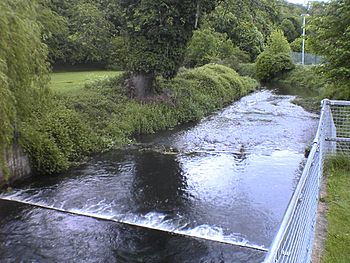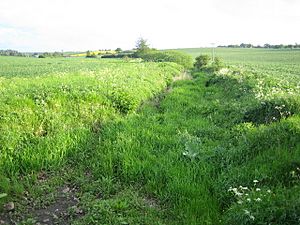River Beane facts for kids
Quick facts for kids Beane |
|
|---|---|

Weir on the River Beane, Hartham Common
|
|
| Country | United Kingdom |
| Physical characteristics | |
| Main source | Nr. Sandon, Hertfordshire 90 m (300 ft) |
| River mouth | Hertford, Hertfordshire into River Lea |
| Length | 17.8 km (11.1 mi) |
The River Beane is a small river in Hertfordshire, England. It's like a helper river, flowing into the bigger River Lea. The Beane starts near Sandon and flows until it meets the Lea in Hertford. It's about 17.8 kilometers (11 miles) long.
Contents
Watermills Along the Beane
For hundreds of years, people used the power of the River Beane to run watermills. These mills helped with different jobs, like grinding grain or making paper. Some of the old buildings and water channels (called mill races) can still be seen today.
Sele Mill: England's First Paper Mill?
- Sele Mill in Hertford is a very old and interesting place. It was even mentioned in the Domesday Book, a famous survey from 1086!
- In the 1400s, this mill was changed to make paper. It's thought to be the very first paper mill in England.
- Paper making might have started there around 1488. We know for sure it was happening in the 1490s.
- A man named John Tate supplied paper from Sele Mill for books published back then.
- Even King Henry VII visited the mill in 1498 and 1499.
- But paper making didn't last long at Sele Mill. It seems to have stopped by 1507.
Walkern Mill: A Historic Building
- Walkern Mill was rebuilt in the 1800s.
- It's now a Grade II listed building, which means it's an important historic place.
Why the River Beane Needs Help
The area around the River Beane is mostly countryside. But many more people have moved to Hertfordshire over the years. This means more water is needed for homes and towns. Because of this, rivers like the Beane have been affected.
Taking Water from the River
- Water was taken from the Beane near Aston to supply water to the town of Stevenage.
- This has caused problems for the river, especially in its upper parts. Too much water was taken from the underground chalk aquifer (a layer of rock that holds water).
- The photo shows a part of the river near Walkern that used to dry up often. From the 1990s until about 2014, water only flowed there at certain times of the year.
- This section of the river was once strong enough to power a watermill! It also used to support watercress beds (plants that grow in water).
- The lower part of the Beane is stronger. Water usually flows well through places like Watton-at-Stone, Stapleford, and Waterford.
- However, the river's overall health has been rated poorly by the Environment Agency, which checks water levels.
Helping the River Beane Recover
People have called for the upper parts of the River Beane to be restored. The goal is to make sure there's enough water flowing all along the river. This way, it can support a healthy chalk stream environment, as good as it should be.
Finding Solutions for More Water
- One idea was to use recycled water from sewage treatment works. Water from Stevenage was usually pumped away from the river for cleaning.
- But it could have been cleaned more and then put back into the Beane.
- In the end, a different plan was chosen. The water company, Affinity Water, was told to take less water from its pumping station near Aston.
- It's hard to find new water sources because the whole River Lea area needs a lot of water.
Improving River Sections
- There have also been projects to make the lower parts of the river better.
- For example, where the river flows through the Woodhall Park estate near Watton.
- In the 1700s, the river here was changed for a park design. But this made it hard for fish to move freely up and down the river. Projects are helping fix this.
Exploring the River Beane
The Herts and Middlesex Wildlife Trust (HMWT) has created a walking trail near Waterford. This trail lets you explore some beautiful parts of the River Beane. It's a great way to see the river and its surroundings!
Images for kids



